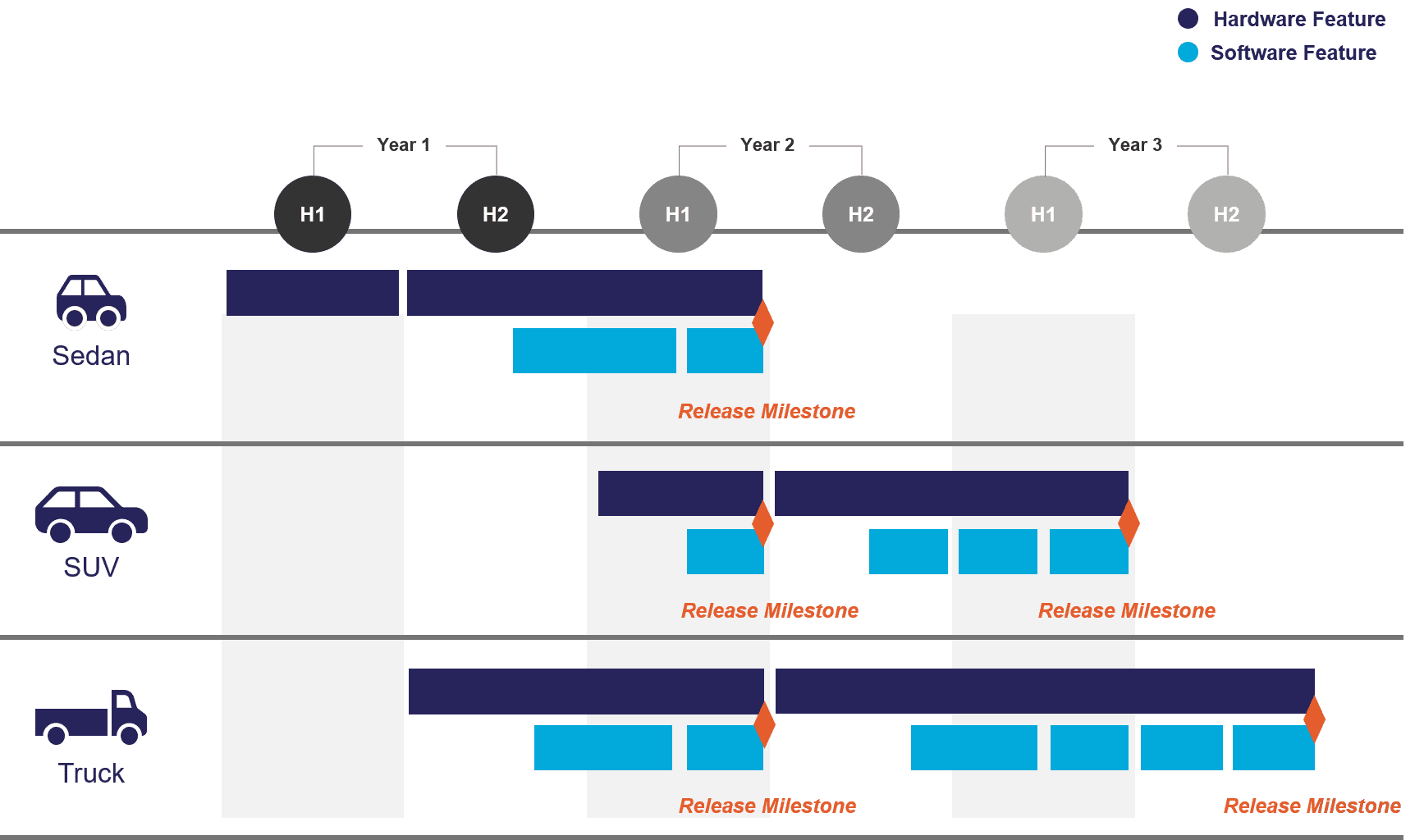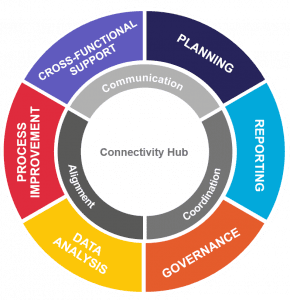New digital technologies are emerging in the automotive industry, especially the demand for connected devices in vehicles. Our client, along with every other global automotive manufacturer, is developing new technology to connect devices, such as smartphones, laptops, and tablets, directly to the vehicle.
Bringing tools together for connected use means that drivers and passengers can interact hands-free with apps and online services from within their own car and gain automated intelligence about the world they are driving in.
Read more about Connectivity in our automotive industry article.
The client is developing a cloud solution for their vehicles to connect to one platform. This not only is a way for current and previous connected vehicles to maintain the latest technology, but it also opens the door for advancements in autonomous driving capabilities.
For example, a connected vehicle might gather information from city traffic alerts and GPS to warn drivers of congestion. In the future this will allow the car to modify its speed on the highway without the driver ever touching the pedals.

However, the development of connectivity technology introduces new challenges to the automotive industry. First, we see that vehicles are becoming a full-service experience with onboard technology and entertainment. The “as a service” offerings for cars are not only more advanced but expected by the market today. Second, not only is the advancement of innovative technologies difficult, but the implementation of such technology poses an even greater challenge to automotive companies. Software development and car manufacturing are very different fields, so merging the two is no easy feat.
Our client struggled with several aspects of this hybrid manufacturing world. They needed to bring an Agile mindset into a traditional project management environment, which dramatically changed the way the program was organized. The traditional engineering and manufacturing of car parts is a process that cannot be fully Agile, while software development is a purely Agile process.
Read also our case study on: Automotive Agile Transformation Pilot
Theoretically, these processes could be decoupled. However, because the end product must fully integrate both hardware and software components, the client needed these processes synchronized.
For example, suppose an SUV is invented for release in three years, and the dashboard is planned to support 15 applications. Once the SUV is released, these applications must be up to date by modern technology standards and still be supported by the hardware planned three years prior.

The client’s program spanned multiple departments and included many external vendors and partners. The client struggled coordinating activities for such diverse groups of people specializing in different fields and services. In the end, communication broke down. They needed a centralized team to coordinate activities and liaise between the different stakeholders.
Therefore, MIGSO-PCUBED was engaged to set up a PMO that could manage the project planning and communications while providing Agile expertise tailored to an automotive manufacturing environment. As a trusted partner of the client for over 25 years, and with our global network of project managers and operations specialists, we could provide contacts and institutional knowledge needed to facilitate effective communications across the program and the organization.
The first step was to set up an effective project planning system. The team needed to plan for hardware components on vehicles to be produced several years out while also incorporating software that could change rapidly. Additionally, the client needed support with their project reporting capabilities to better understand project status and to improve their processes.
MIGSO-PCUBED deployed a team of project managers and operational specialists to set up a PMO for the client’s automotive connectivity program. Ultimately, the PMO was responsible for:
The PMO acted as the central hub connecting each project and stakeholder group. Initially, they set up a structure for the program to plan future projects as part of their connectivity platform.
Learn more about how to set up a PMO.
In the introductory planning phase, the team focused on bringing together all stakeholders and coordinating the activities of different groups. They set up communications plans to align project teams, program sponsors, and external vendors who play a key role in various project deliverables. Then, the team worked with the client to develop a roadmap for future vehicle enhancements and product development as part of their connectivity platform.

Our team was able to implement the Agile processes our client desired, allowing them flexibility while planning for long-term product development. Even today, the team works with the client to continuously improve the program’s agility.
In addition to facilitating communications across the program, our team also established effective reporting mechanisms for the client to track project and program status, including:
The team established governance meetings to share KPIs, follow up on any needed actions, and coordinate related team activities.
While monitoring and reporting on these various program functions, our team identified an opportunity to improve the program’s reporting processes. More data is useful to measure progress and quantify risks or opportunities. However, the more KPIs there were to track, the more difficult it was to keep Excel spreadsheets up to date.
Therefore, the team developed digital dashboards using a business intelligence reporting tool to create dynamic and automated reports. This allowed the client to quickly identify and act on risks, issues, and opportunities. Additionally, they could easily discover inefficiencies and areas for improvement in their processes.
Thanks to the MIGSO-PCUBED team, the client established an effective PMO that enabled Agile practices within the organization’s traditional manufacturing processes. The team established:
As a central liaison and as experts in project management, the PMO team ensured messages were well-coordinated with project milestones, program objectives, and organizational strategy. By facilitating communications and coordinating activities across different teams, departments, and vendors, the MP team saved the client time and reduced errors caused by miscommunications. They also improved stakeholder relations, especially with external partners, and increased the program’s productivity.
Today, the MIGSO-PCUBED team of consultants continues to support the client’s Connectivity PMO by planning, reporting, monitoring, and leading activities for the program. By alleviating the burden of managing and coordinating activities across the program, our team enables the client to focus on innovating and developing the most advanced connected vehicle products.
Loved what you just read?
Let's stay in touch.
No spam, only great things to read in our newsletter.
We combine our expertise with a fine knowledge of the industry to deliver high-value project management services.
MIGSO-PCUBED is part of the ALTEN group.
Find us around the world
Australia – Canada – France – Germany – Italy – Mexico – Portugal – Romania – South East Asia – Spain – Switzerland – United Kingdom – United States
© 2024 MIGSO-PCUBED. All rights reserved | Legal information | Privacy Policy | Cookie Settings | Intranet
Perfect jobs also result from great environments : the team, its culture and energy.
So tell us more about you : who you are, your project, your ambitions,
and let’s find your next step together.
Dear candidates, please note that you will only be contacted via email from the following domain: migso-pcubed.com. Please remain vigilant and ensure that you interact exclusively with our official websites. The MIGSO-PCUBED Team
Choose your language

A monthly digest of our best articles on all things Project Management.
Our website is not supported on this browser
The browser you are using (Internet Explorer) cannot display our content.
Please come back on a more recent browser to have the best experience possible
